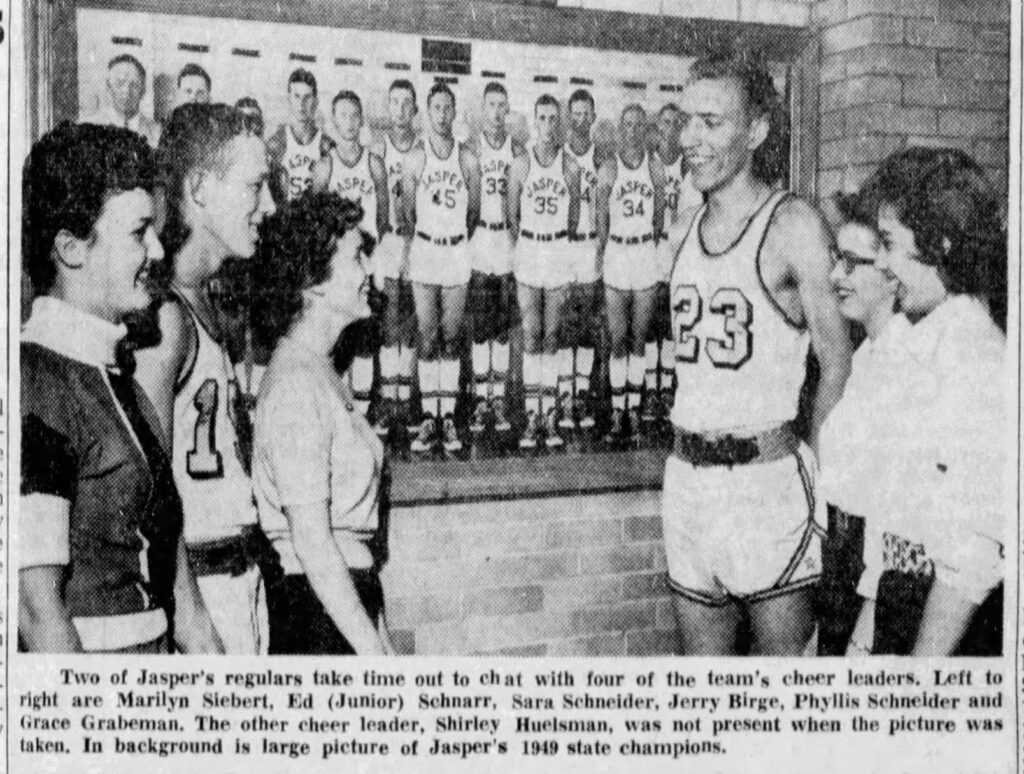Indiana high school sports lost a valuable man recently. From the late 1960s and fifteen years beyond, Indiana sports writer Jerry Birge doggedly produced an article for every issue of the Jasper Herald in his sports column, Keeping Score. For the few years of its existence, Birge also helped create and write for a wonderful regional basketball magazine, Hoopla, which offered stories about the basketball teams that feed into the Evansville semi-state in the southwest corner of Indiana.
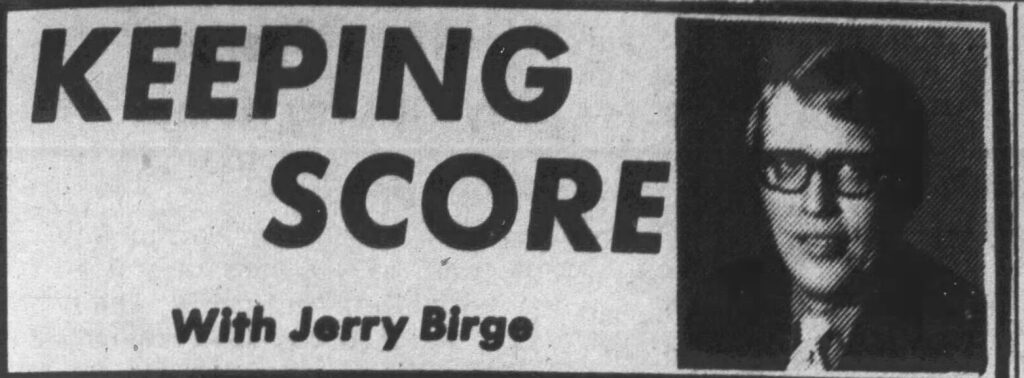
Jerry claimed in a recent interview with me that he was not a particularly gifted writer, that his gift was just a good memory that he pulled from to put together a column. I disagree. When you read his stuff, you sense the research behind it, sense too that with each draft, important themes emerged, themes that Jerry captured so wonderfully in words. And when Birge spun a narrative about a team, a coach, or a player, he often wrote from the heart as well as the head.
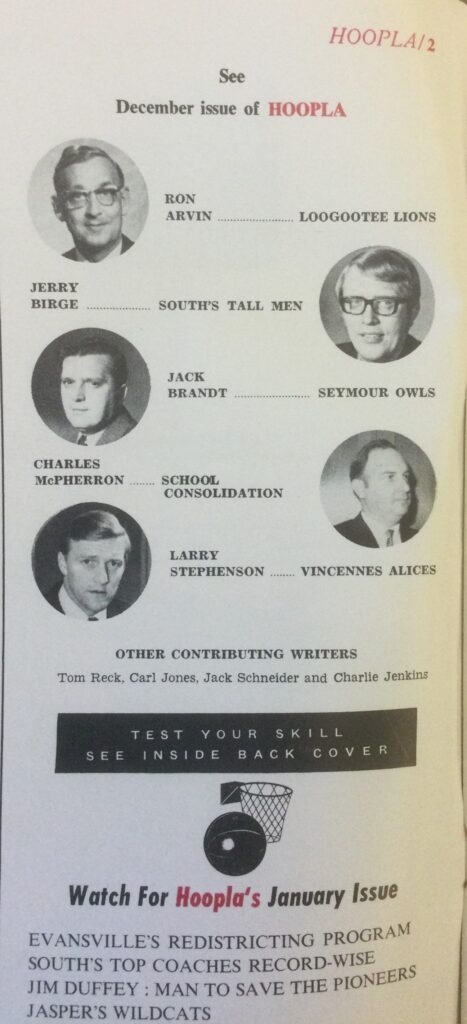
Jerry also told me that he was fortunate to be writing in basketball-crazy Indiana, where dramatic writing material was as deep and wide as an ocean and as exciting as any writer could ever hope for. “It was,” explained Jerry, “a golden age of high school basketball.” Birge was certainly correct on that latter point. At the height of single class play in the 1960s and through the 1970s, every local and big-town newspaper, thick with pages, had a large sports section. The bigger outlets often had multiple sports writers. These writers pumped out lengthy, colorful columns about sporting events and about athletes in a way that made you think that everything depended on the outcome of a particular basketball game. Such detailed local media reports hardly exist today, but in that golden age of Indiana high school basketball, it was sportswriters such as Jerry Birge who spun the stories of teams and individuals, setting the themes and chronicling the consequences of human actions during the Indiana high school basketball season. These rich stories ultimately helped create the wonderful legends that still echo in small Indiana communities today.
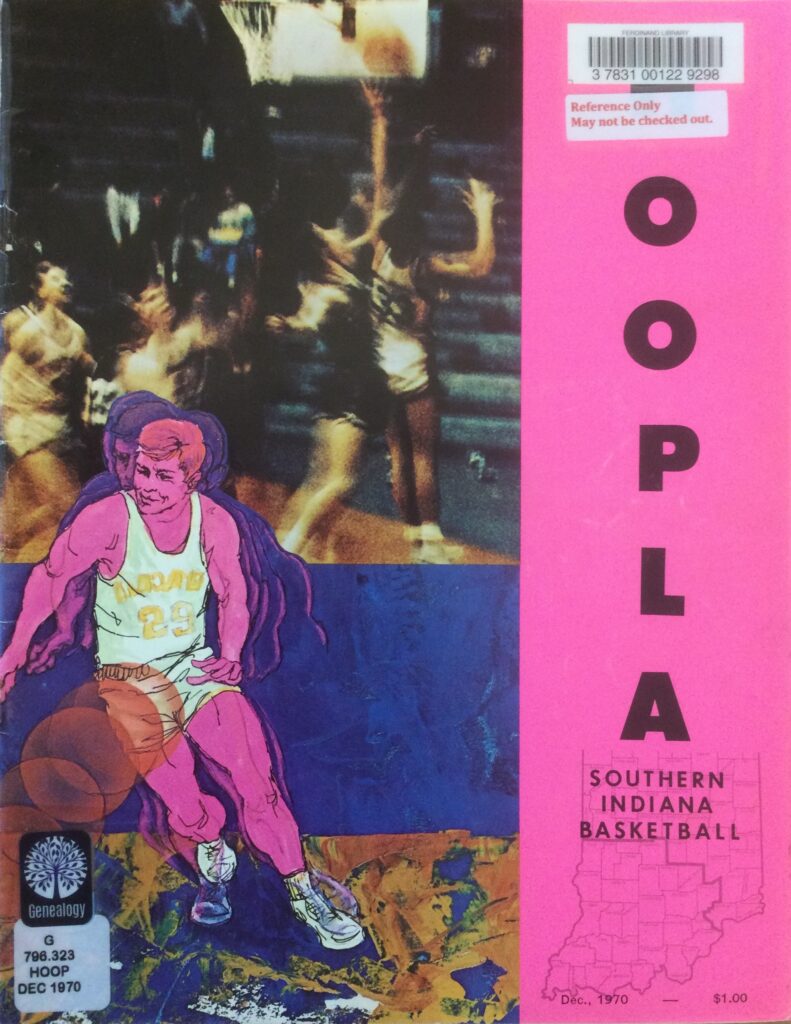
Interestingly too, Birge was credited by every major biography about Larry Bird for being the sports writer who first helped get Larry recognized by other sports experts in the rest of the state during Bird’s unexpected and spectacular senior year. In his column, Keeping Score, under the title “High Flying Blackhawk,” Birge penned a super write up in mid-January of 1974 about Larry and the Springs Valley team. In part, Birge asserted, “One only needs to check the results of area high school basketball games to discover the hottest team on the hardwoods heading into the last half of the season, and, without a doubt, the most exciting—if not the most talented—individual player of the year.” After losing two of their first three games, the Blackhawks, noted Birge, “Have done a complete reversal, winning their last eight outings, most of them by impressive scores. The Blackhawks steamrolled over West Washington (98-45) and Corydon (99-73) this past weekend, and in the process, the high-flying Bird left the nets limp in the West Washington and Springs Valley gyms. They were still smoking yesterday morning after Bird touched them for 42 points Friday night (at West Washington) and an incredible 55 points Saturday night at Valley.” Birge ended the article arguing that “area coaches will face quite a task when they meet the Hawks in tournament time.”
When sports writers in the central and northern parts of the state ignored Larry Bird when the All-Star team was selected, Jerry went to work on that too, writing a column titled “It’s for the Birds.” Birge’s ongoing efforts in Larry’s behalf are said to have played an essential role in Bird finally making the All-State team when the state’s coaches had their say.
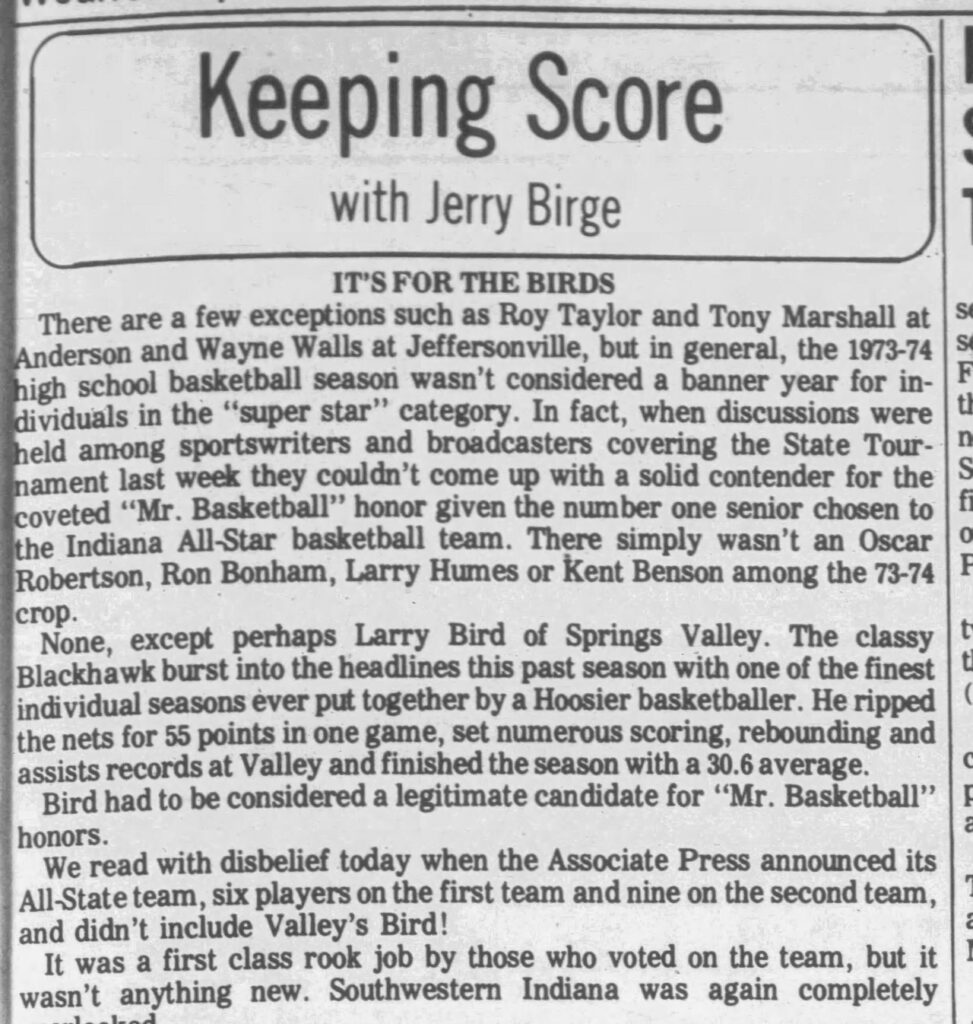
Jerry Birge loved his Jasper Wildcats too, having started on the Wildcat basketball team with a group called the Five J’s by Jasper High School basketball fans- Jody Giesler, Jim Eckerle, Jerry Birge, John Hoffman, and Junie Schnarr. The team made the game fun to watch in the 1956-1957 season, coming within a whisker of going to the state finals after beating Evansville Lincoln in a sudden death second overtime in the first game of the Evansville semi-state in the new Roberts Stadium. But as a sports writer, Jerry could be tough on the Wildcats in his columns if he thought the team was not playing up to par.
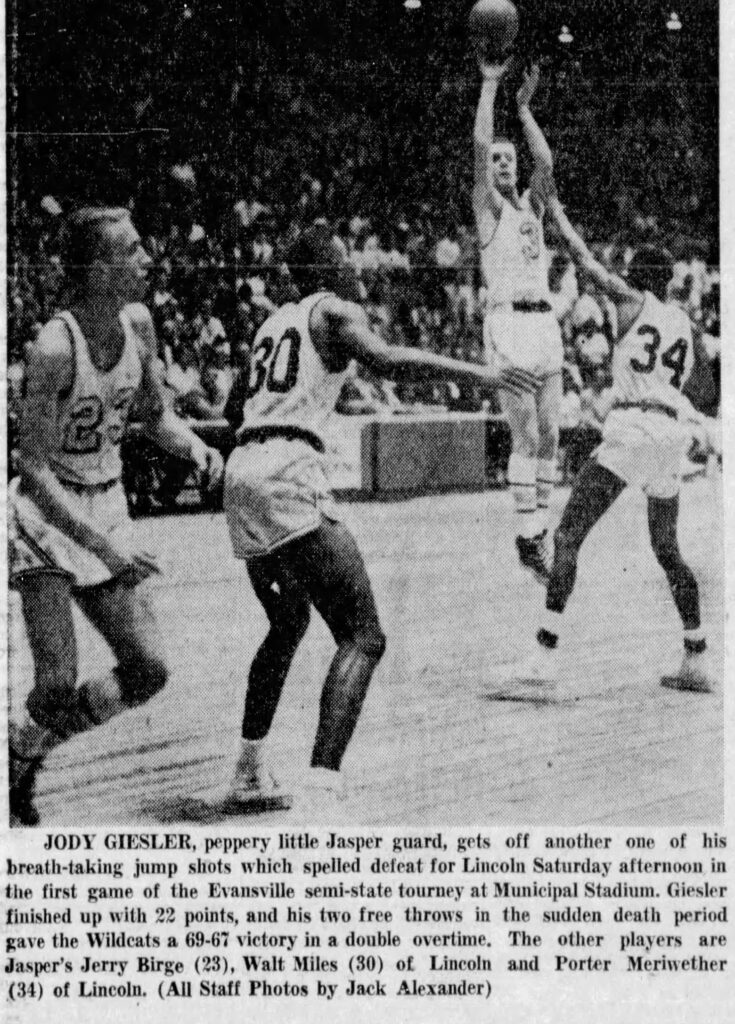
Perhaps the most amazing thing about Jerry Birge wasn’t the homage in words that he paid to the greatest high school basketball players, teams, and coaches, but rather his deep understanding of the archetype that under-girded the state’s mad love for the game. Birge understood that Hoosiers loved high school basketball because it touched upon the importance of community, the Indiana citizens’ devotion to egalitarianism, and a Hoosier’s love of the underdog. As sports historian Herb Schwomeyer has suggested, narratives about Indiana high school basketball have celebrated these values to the point of creating a cultural mythology, as over the years Hoosier communities of every size flocked “to their local gymnasium to cheer on their team.”
Nowhere is Jerry Birge’s understanding of this mythology better captured than in his early 1970s reporting about the basketball team of one of the smallest schools in the state, Birdseye High School, and about their star player, Jeff Cook, who Birge crowned the “Splendid Splinter.”
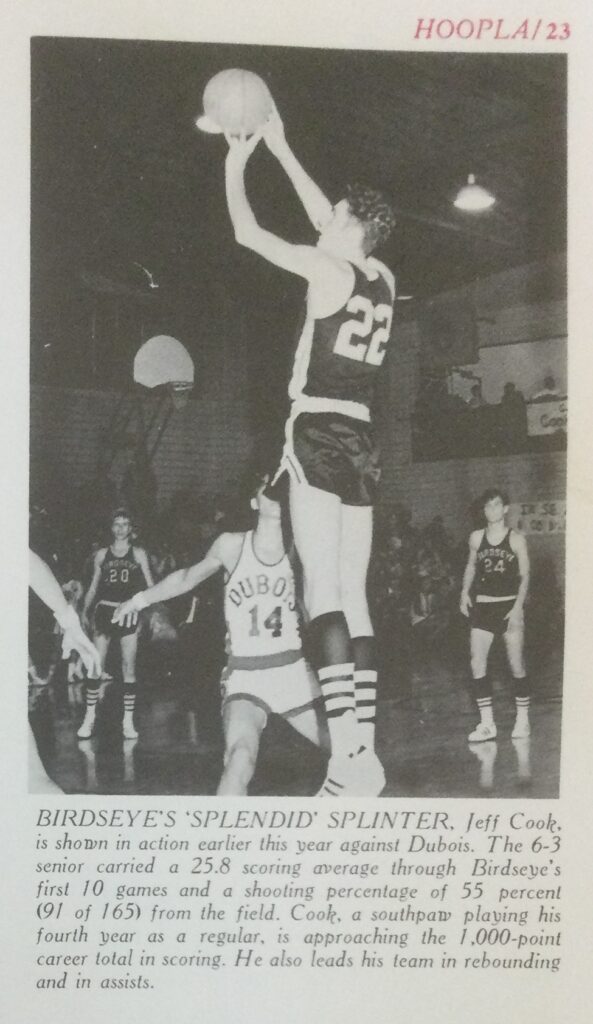
Birge gave plenty of press to both Cook and the Birdseye Yellow Jackets, covering them in both the Herald and in Hoopla Magazine in what became Birdseye’s best season ever, just before the tiny school was swallowed up into the Southeast Dubois school system.
Sadly, the days of such sports productions are gone, along with the family owned local newspapers. And gone now is one of the wonderful sports writers of that era. All we can do is say “thank you Jerry” for all those great stories you gave us back in that golden age of high school basketball.
